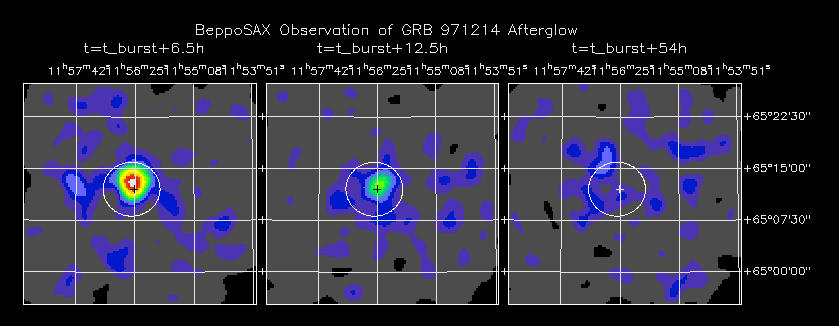
The gamma ray burst GRB 971214 was discovered by BeppoSAX simultaneously in the Gamma Ray Burst Monitor and in the Wide Field Cameras on Dec. 14.97272 UT. A team of scientists at the Scientific Operations Center(SOC) in Rome derived its approximate position and quikly communicated it to several major ground and space-based observatory for fast follow-up observations. The quick-look analysis, performed at SOC and SRON, shows that GRB 971214 is a structured gamma ray burst lasting about 25 s with a peak flux of 650 counts/s. The peak of the X-ray flux, simultaneously measured by WFC, was about 1 Crab. The WFC position from the quick-look analysis is R.A. = 11h56m30s, Decl.= +65o12'.0 (equinox 2000.0), with an error radius of 3'.9 (99-percent confidence).
A fast follow-up observation of GRB971214 was subsequently carried out by BeppoSAX 6 hours 40 minutes after the initial burst with an exposure time of over 100,000 s. The analysis of the data from the BeppoSAX X-ray telescopes was performed at the BeppoSAX Science Data Center and showed that a previously unknown X-ray source (1SAXJ1156.4+6513) was clearly present within the WFC error circle. The average source count rate in the 1.3-10 keV was 0.0056+/-0.0005 cts/s (two MECS units) and 0.0036+/-0.0005 cts/s in the LECS (0.1-5 keV) corresponding to a 2-10 keV flux of 4 x 10E-13 erg cmE-2 sE-1. Source position is R.A.=11h56m25s,Decl.=+65o13'11" (equinox 2000.0). The error radius is about 1', and it is currently dominated by systematics in the position reconstruction with the new 1-gyro mode. The position of the Optical Transient (IAUC 6788) is consistent with that of the X-ray source. From a preliminary analysis of the first day of observation the source faded by a factor of about 5 in several hours.
Three MECS snapshots, lasting approximatively 2 hours each, are shown below. The fast deacay of the X-ray flux is clearly visible.

The big white circle is the WFC error region, the small cross shows the position of the optical transient reported in IAUC 6788.We conclude that the previously unknown and fading source (1SAX J1156.4+6513) must be associated with GRB 971214.